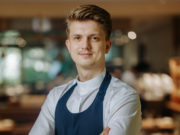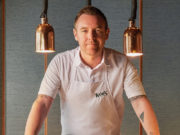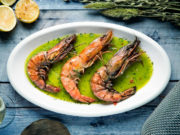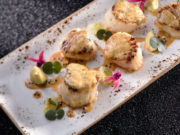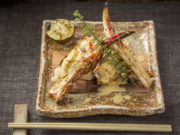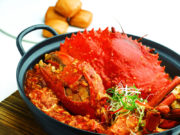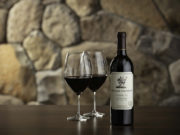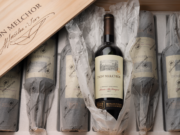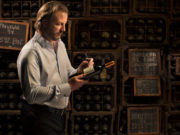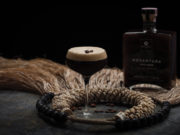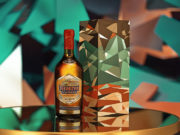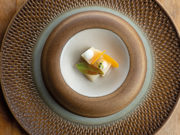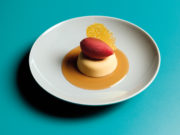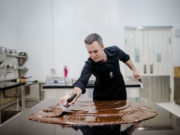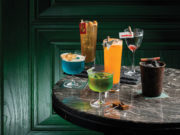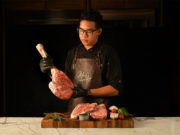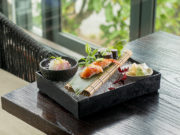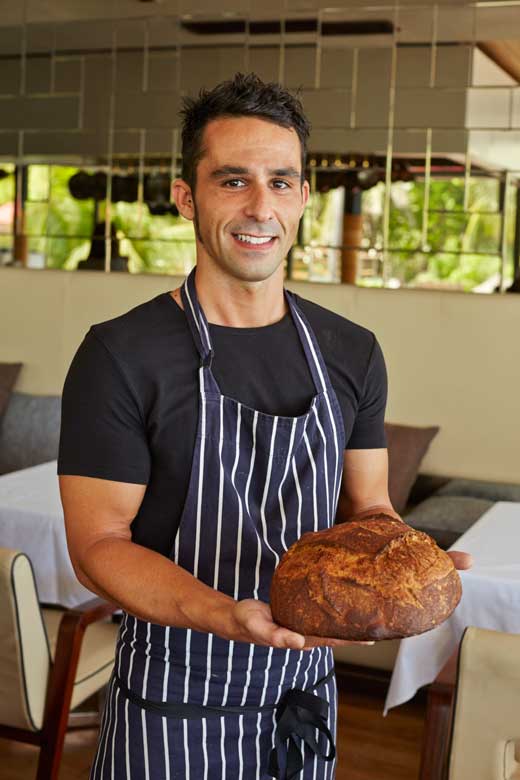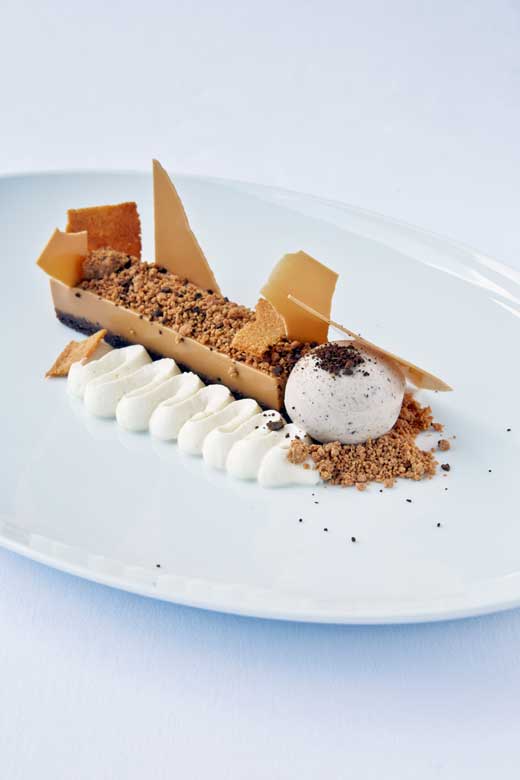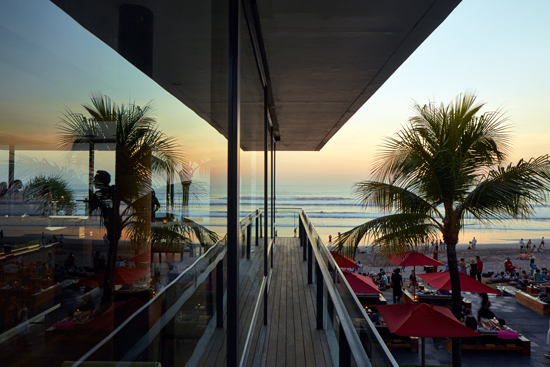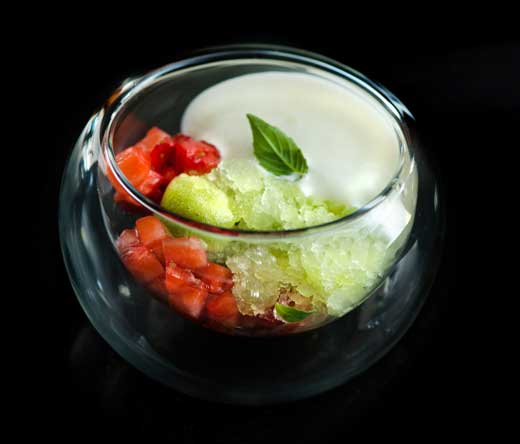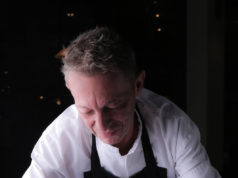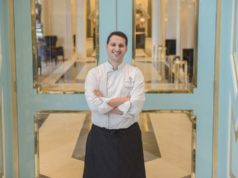Exquisite Taste meets KU DE TA Seminyak’s recently appointed Executive Pastry Chef,
Nuño Garcia
Exquisite Taste was excited to meet up with him over coffee and find out just what makes him tick. After earning his spurs at the famous two Michelin-starred Miramar Restaurant in Girona, Chef Garcia has worked in other Michelin-starred restaurants in England and Singapore before finding his way to this little patch of paradise in Bali – his credentials are good!
Q: What brought you to KU DE TA and to Bali?
A: The connections already existed and I knew about the job opening from Will and some other friends. It was very exciting as I knew the island and the company already, so I didn’t hesitate to take up the chance
The place is amazing; it’s a very comfortable place to work. KU DE TA is a famous company and I knew it would be busy all the time – I enjoy being busy and realised it would be a showcase for my skills. A place where I would be able to collaborate and add my experience and style to the house, and it’s great since I have 100 percent creative freedom here.
Q: So what is your style?
A: I have good training and experience in all the pastry fields, so I am good at baking, chocolate, modern deserts as well as classic deserts. So here, my idea, my purpose if you like, is to use 100 percent Balinese products, especially upstairs in Mejekawi to create exciting desserts for the degustation menu. While downstairs it’s more casual, so I go for safer creations with chocolates, berries.
Q: What is your favourite local product?
A: I love the coconut here, some of the spices and herbs too. We can do anything with the kitchen laboratory that we have at KU DE TA , which means experimentation and creativity feature heavily in our menu design.
Q: With different ingredients available it must be exciting. Where do you get your inspiration from?
A: From all over the place, sometimes I will just call up the supplier and ask him to bring as many things as he can in terms of fruits and herbs… We then sit down with the chef, taste it and just experiment. This gives you an idea of what you can do with that particular ingredient and the ideas will follow.
Q: The kitchen laboratory is amazing – so what is your favourite piece of equipment / gadget?
A: We have very good machines here and we use all of them a lot. The blast freezer, which because of the temperature and the humidity, is vital because it freezes super-fast. We also have some liquid nitrogen equipment that gives us time to play with some granitas, ice-creams and things like that. Everything is great, and I have a big team, so I don’t have to be hands on all the time, I can be doing my creative thing while the guys take care of the day-to-day.
Q: Are you training the team?
A: The previous team worked very hard on training and the guys already have great skills. For me, I have just given my own preferences, some small changes here and there, but it’s pretty much the same style.
Q: Do you bring any childhood influences into your cooking?
A: Yes, I do. For example, there are these little pastries I used to have as a kid in Spain and I like to reproduce them but in my own style. But even if it’s reproducing simple things like a chocolate bar, a Snickers or a Mars, I do like to make my own version of these too.
Q: Do you have a personal signature pastry?
A: My work with chocolate is probably my signature. I worked with a few chocolate shops in Europe and I always like to have something special with chocolate on my menus.
Q: Where do you get your chocolate from?
A: I get the chocolate from local producers – Big Tree Farm and Primo Bali, and in fact I am designing my chocolate with Primo Bali right now. I tell them exactly what I want – flavour / texture – and they try to produce and supply it for me. I visited the plantations last month and we worked together. They grind small batches and I can taste it before production, which is ideal. Working with products from field to table is not an opportunity that chefs get in many places.
Q: Do you have any other ingredients that go from plantation to table with your input?
A: In fact, yes. We have a particular small organic supplier who we are working with to improve basic local ingredients, like mangoes, for example. To ensure the best quality, he will even bring small 2kg batches of any fresh produce as it becomes available and we adapt our menus depending on what we have.
Q: Do you have any special new ideas you are planning for your 2015 menus?
A: Of course! Just last week I changed the menu in Mejekawi, but I’ve only been here six months, so I still want to see more things before I make bigger changes. Downstairs, in KU DE TA , I have been working with the bakers a lot for the breakfast items and have just finished my first shot at new bakery items.
Once you make the dough, it’s alive. It’s sensitive to temperature and many other things, so when you bake and you see your result, it’s a wonderful thing. It’s very satisfying and fulfilling to bake and is a good place to start!
Q: As a 6-month veteran on the island, what do you think the biggest challenges are to being a successful pastry chef in Bali?
A: You have to be very flexible because many products you might be used to using are just not available here, or are so expensive that there is no point buying them. You have to be open to working with local ingredients. Also you have to get used to working with the local people; it’s different from working overseas, their background is different and attitudes are different. Technically, temperature control is also very difficult here and the humidity – especially for pastry – can be challenging.
Q: Asia is a melting pot of great dining and Bali is growing into a culinary destination. What do you see as being the pastry trends for 2015?
A: Generally, I think many pastry chefs are going back to the basics. They are back to focusing onto the product and concentrating less on the plating. I think we had got to the stage where we were plating something that looked amazing, but we’d lost the taste. When you put it in your mouth, you were disappointed. Many chefs are going back to the old school where the most important thing is the produce.
In simple terms, the rules are don’t overcook or over process, and I’m very happy to see this trend and welcome it.
Q: What advice do you have for budding pastry chefs?
A: You have to be very passionate and be strong both physically and mentally because you’ll spend many years working for excellent, but hard, chefs. The hours too are very long, although it is hugely rewarding. I would say to anyone that you need to be very clear that you want this career.
Q: With that in mind why did you pick pastries above anything else?
A: When I was a kid I was a bit of a rebel, I didn’t want to study but my father told me that I had better study something I liked or he would pick something for me. I picked cooking school, but I had no idea that I would love it so much. We learned everything, of course, and had only maybe two hours a week of pastry, but I was drawn to it. So when I finished school, I just applied for pastry chef positions, it was all that I wanted to do.
My final target is to open my own business at some point, perhaps in my home town of Barcelona. That’s what I think about when I’m really tired or really stressed, I just remember it is all part of my plan and one day, I will have my own place.
Signature dessert Recipe
by Chef Nuño Garcia:
THAI BASIL SORBET
(cucumber granite, home-made milk curd and strawberries)
Simple, delicious and easy on the eye!
Ingredients
1450g water
350g sugar
20g inverted sugar
100g glucose
8g Pregel sorbet
7g stabilizer sorbet
200g lemon juice
30g Thai basil leaves
35g Italian basil leaves
Method
1. Mix the water, glucose and inverted sugar together in a pan and warm to 40°C.
2. Add the sugar previously mixed with the stabilizer.
3. Boil and then remove from heat and cool to 4°C.
4. Add the lemon juice and blend. Rest the mix for 12 hours in the fridge.
5. Mix in the Thai and Italian basil leaves and place into Pacojet, or similar canisters, before returning to the freezer.
6. Serve scoops straight from the freezer… Enjoy!


